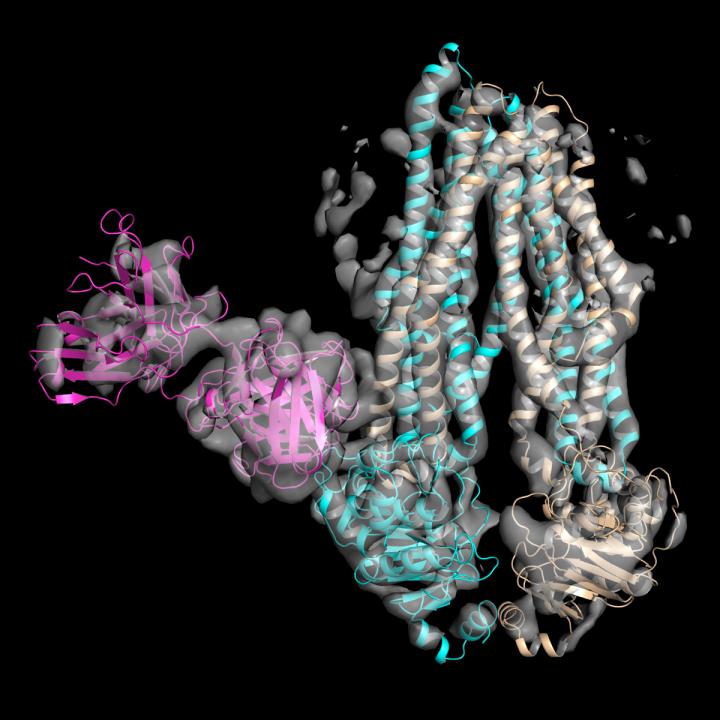How cells defend themselves against antibiotics and cytostatic agents

With the aid of a high-resolution cryo-electron microscope, the group led by Robert Tampé, in collaboration with colleagues at the University of California in San Francisco, succeeded in determining the structure of an asymmetrical ABC transporter complex. Credit: Robert Tampé
“On the one hand, ABC transporters causes diseases such as cystic fibrosis, while on the other hand they are responsible for the immune system recognising infected cells or cancer cells,” explains Professor Robert Tampé from the Institute for Biochemistry at the Goethe University.
The considerable medical, industrial and economic significance of ABC transporters is also based on the fact that they cause bacteria and other pathogens to become resistant to antibiotics. Likewise, they can help cancer cells to defend themselves against cytostatic agents and thus determine whether chemotherapy will succeed.
For the first time, the group led by Robert Tampé, in collaboration with colleagues at the University of California in San Francisco, succeeded in determining the structure of an asymmetrical ABC transporter complex with the aid of a high-resolution cryo-electron microscope.
“Over a period of five years, we have successfully implemented a number of innovative, methodological developments. These have enabled us to gain insights that previously were unimaginable,” says Tampé.
The researchers report in the current issue of the renowned scientific journal, Nature that they have succeeded in investigating a single frozen ABC transport complex at a subnanometer resolution that has never before been achieved.
For this purpose, they used a newly developed single electron camera, new imaging processes and specific antibody fragments in order to determine the structure and conformation of the dynamic transport machine.
“The combination of physical, biotechnological, biochemical and structural biological methods has led to a quantum leap in the elucidation of the structure of macromolecular complexes,” says Tampé. The method facilitates the targeted development of a trend-setting therapeutic approach.
Media Contact
All latest news from the category: Life Sciences and Chemistry
Articles and reports from the Life Sciences and chemistry area deal with applied and basic research into modern biology, chemistry and human medicine.
Valuable information can be found on a range of life sciences fields including bacteriology, biochemistry, bionics, bioinformatics, biophysics, biotechnology, genetics, geobotany, human biology, marine biology, microbiology, molecular biology, cellular biology, zoology, bioinorganic chemistry, microchemistry and environmental chemistry.
Newest articles

Bringing bio-inspired robots to life
Nebraska researcher Eric Markvicka gets NSF CAREER Award to pursue manufacture of novel materials for soft robotics and stretchable electronics. Engineers are increasingly eager to develop robots that mimic the…

Bella moths use poison to attract mates
Scientists are closer to finding out how. Pyrrolizidine alkaloids are as bitter and toxic as they are hard to pronounce. They’re produced by several different types of plants and are…

AI tool creates ‘synthetic’ images of cells
…for enhanced microscopy analysis. Observing individual cells through microscopes can reveal a range of important cell biological phenomena that frequently play a role in human diseases, but the process of…





















